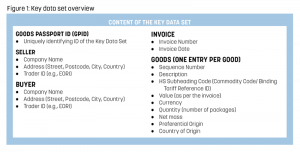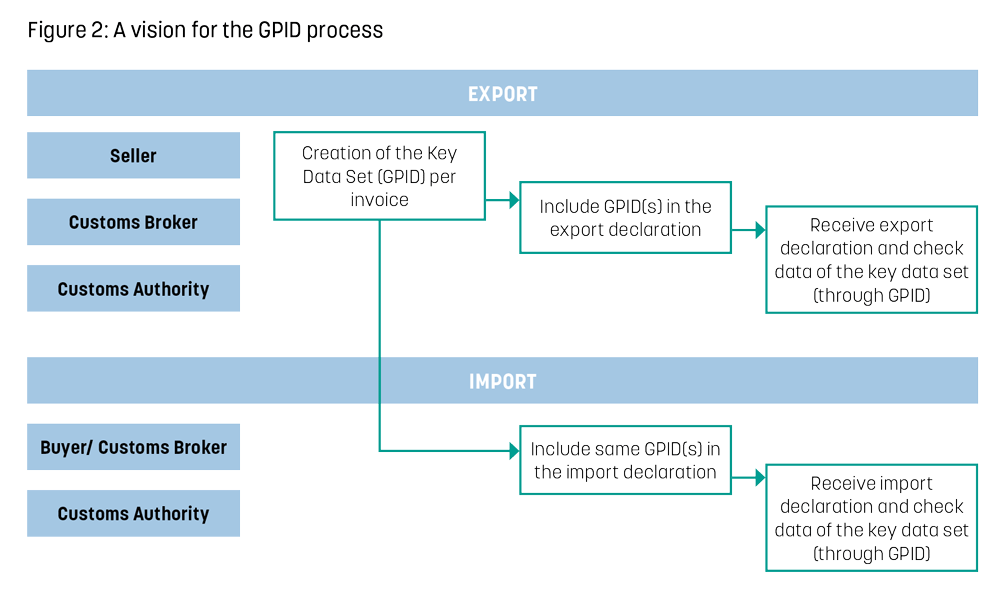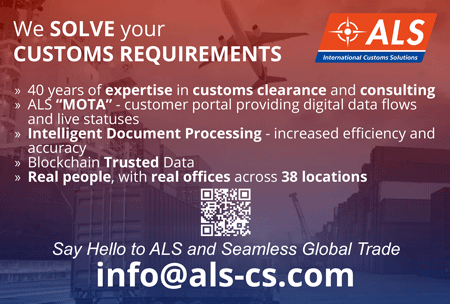Open Customs Blockchain: The missing piece to unlocking the broad application of distributed ledger technology for Customs?
16 June 2023
By the Open Logistics FoundationDigitalization has simplified Customs clearance in many areas, especially in the declaration of imports and exports. However, various data discontinuities and queries unnecessarily delay cross-border process flows. A group of major logistics companies, software providers and researchers is driving an initiative which could change this. Called the “Open Customs Blockchain”, it focuses on developing and applying blockchain technology for the exchange of key Customs data in foreign trade. The best part: the jointly developed software components will be published publicly under an open-source licence. This article looks at why previous projects and initiatives have not yet achieved the widespread use of blockchain, and what is so different about the open-source approach that just might be the missing piece to unlocking broad and standardized application.
Why blockchain
Blockchain is a decentralized, distributed, tamper-proof and cooperatively used form of data storage. It is based on distributed ledger technology, similar to an actual cash book in which information is recorded. Several entries are chronologically combined in blocks, which in turn are linked together with the help of a cryptographic “fingerprint”, the hash. Hence, this chain of blocks is called a blockchain. By adding so-called “smart contracts”, programmed “if‑then” conditions, it is also possible to automate sub-processes, for example, to execute predefined actions.
In blockchain networks, a secure exchange of data is possible even without a central instance, since every network participant has an identical copy of the “cash book”, and the correctness of the entries is jointly checked and confirmed by the participants. Applying the technology for the exchange of data between several companies could enable companies and authorities to interweave the flow of goods and the flow of information in foreign trade more closely and simplify Customs clearance for all parties involved.
The added value of blockchain usage lies in the tamper-proof provision of the relevant data at an early stage in the process and in feeding information on Customs clearance back into the logistics process to make it available to the other players up and downstream of the supply chain. In this way, more transparency – and thus more trust – is created in supply chain networks across borders and, at the same time, paper-based documentation is reduced.
Transparency in this case does not mean that all information is accessible to everyone without exception. A targeted role and rights concept enables data access according to the needs of each participant.
In the long term, there are greater opportunities from the integration of Customs authorities. By integrating national Customs offices into corresponding blockchain networks, it will be possible to access a reliable and up-to-date source of information at all times, for declarations, clearance, and also for the subsequent inspection of imports and exports. Companies and authorities could benefit from a reduced number of contacts as Customs brokers and Customs officials at home and abroad would be able to trace information on import and export processes at any time and without any doubt.
Goods Passport ID, a set of essential information
Currently there are many proposed solutions worldwide that require multiple parties to agree to large and complex data sets. However, the coordination processes for this are very cumbersome and once an agreement has been reached, the technical implementation is often just as complex. Moreover, the volume of data collected by authorities and entered by economic operators may be larger than would actually be necessary for the process handling. In a paper by researchers from the University of Surrey on a United Kingdom (UK) Government project that sought to identify if using blockchain technology could reduce friction at borders,[1] the UK Customs authority (HMRC) stated “we will only need to check key data fields”.
Because of this, when designing the Open Customs Blockchain, we decided to focus instead on a set of essential information that authorities see as being the main source of fraud and duty evasion. We named this key data set “Goods Passport ID” or “GPID”. It contains data that is required at various steps along an export/import process and that is needed repeatedly by multiple stakeholders (e. g. Customs authorities, forwarders, buyers and sellers): basic information on the seller, the buyer, the invoice (value, quantity), origin and classification of the goods traded. This is the data that authorities normally focus on to detect fraud and duty evasion (see Figure 1).

The Goods Passport ID is the blockchain identification number for the “key data set” of a given invoice. Via the GPID, the corresponding key data set can be found and accessed on the blockchain.
How many GPIDs are there in a process? There is one GPID per invoice and one invoice per GPID. Once a GPID has been created for one specific invoice, this invoice cannot be submitted to the blockchain again by creating a different GPID.
Can the GPID be manipulated? No. Once a GPID has been created for one specific invoice, this identifier cannot be changed.
Can the key data set be amended? Yes. It is possible to add or edit certain (but not all) entries of an already existing key data set. The changes made and the authorship of those changes are logged on the blockchain in a change history.
This project brings together the most diverse actors in Customs processes: declarant, seller, buyer, Customs service provider, carrier, Customs authorities … and even across countries. This creates a binding, common data truth. It will enable our customers to organize their Customs processes in a completely new way with the goal of higher automation, data quality and transparency.
Dr. Ulrich Lison, AEB SE
The process of using such a reduced data set, as demonstrated in Figure 2, starts with the seller (in this case identical to the exporter). Concurrently with issuing a commercial invoice, the seller will issue a key data set and store it on the blockchain. This data set can then be forwarded to brokers, LSPs and Customs authorities in both the country of export and the country of import via blockchain. It can add value and trust as it represents a tamper‑proof source of crucial information that can be referenced in Customs declarations and is also available for spot checks at the physical border or post‑clearance audits.

Extending the data set
With further development, extension of the key data set usage for security controls, RFID gates, weighbridges, and other applications that do not require full data sets, is conceivable. What is more, by shifting towards the blockchain-based sharing of Customs information, data duplication from entering data multiple times, manually or automatically, can be reduced. Provided that blockchain-supported data exchange is adopted, then extension to export control, compliance with reporting obligations, licence monitoring, or automated Customs valuation, would also be conceivable.
We offer neutral, cross-company collaboration to achieve broad acceptance of common solutions, independent of individual interests. For blockchain in general and the Customs use case in particular, these are the same requirements: Creating a generally accepted format and establishing a neutral solution.
Andreas Nettstraeter, Open Logistics Foundation
A look around
However, introducing blockchain technology into logistics, and even Customs, processes is nothing radically new. It has been tried before – the idea is promising, and the undertaking is complicated. The main obstacles to introducing blockchain into the Customs domain include a lack of expertise, the cost, and poor adoption by other stakeholders.[2] Overcoming these hurdles has proven to be incredibly difficult. In a questionnaire to the 183 WCO Members, the responses highlighted that only Argentina and Uruguay had reported full deployment of blockchain and Distributed Ledger Technologies[3]. Other projects and initiatives remain at various stages of progress, while some have been discontinued.
Ongoing projects include the European Commission research project “SEED-on-Blockchain”, and “Made in Italy”, which is an initiative to use blockchain to certify high-quality products at various levels. Georgia issues preferential CoOs with data stored on blockchain, and Australia ran a PoC with Singapore that authenticated the provenance of CoOs using blockchain.[4] Further prominent examples include the long-standing blockchain project CADENA, which has seen a number of South American countries exchange AEO information with beneficial results, as well as Mercosur’s bConnect project, which follows the same aim.
One of the notable commercial successes has been the Egyptian Government’s agreement with CargoX to use its blockchain document transfer gateway. They state that the average cargo release time has decreased from 29 days to 9 days.[5] However, it comes at a cost to traders or LSPs and is primarily a document-based blockchain rather than data-based. The service comes with the benefit of reduced delays, but there is a cost for each document on the blockchain (e.g., USD 60 for a Guarantee of Origin).[6]
On the other hand, there are projects that started with the same aim, but have since been discontinued. According to official statements, the TradeLens blockchain platform (founded by Maersk and IBM) was discontinued because the level of support and cooperation needed for it to succeed was not achieved.[7] More specifically, there were uncertainties in terms of governance processes, scalability and profitability for each participant.
Open source is the solution
For future projects, this underlines the importance of an open approach regarding decision processes, software development and governance structures. An open-source development approach, which is primarily a means of achieving critical mass of technology deployment and only secondarily strives for a commercial solution, could provide an answer here.
However, such common open-source development, as proposed here, requires agreement on a set of standards. This has been recognized, as a WTO paper concluded: “Blockchain could make international trade smarter, but smart trade requires smart standardization – and smart standardization can only happen through cooperation.”[8]
The truth is that many delays are the result of a (natural) lack of trust: authorities need to protect their territories against tax/duty evasion, fraud, smuggling, and criminals. Introducing blockchain technology into Customs processes can facilitate the building of trust.
Michael Douglas, ALS Customs Services
The approach focuses on the simplicity of the data sets that are exchanged and on recognizing that authority participation is crucial to achieving the benefits that blockchain promises for reducing border delays. The GPID is different because it is a solution that helps authorities to help honest stakeholders. It is different because it is based on open-source software instead of isolated commercial solutions. It is easier to handle because it is easier to reach agreement over a smaller, simpler data set than a complex one, and thus consensus can be reached faster.
Customs participation in building common standards is crucial
The opportunity to overcome fragmented systems and increase visibility within cross-border supply chains lies in developing and introducing open-source blockchain applications based on joint standards into Customs processes. To do so, it is necessary to build common standards together with logistics service providers, Customs brokers, and software providers, with guidance and oversight from Customs authorities. These standardized basic functionalities can be developed by the logistics and Customs community, allowing companies to share development risks and costs. On top of these basic components, each company can then build and offer individual, market-differentiating services and solutions. This is the approach advocated and represented by the Open Logistics Foundation.
We have already built software, which we now seek to deploy. Customs authorities and other parties interested in taking part in a Live Pilot to test out the first available functions of the Open Customs Blockchain and shape future standards together with key logistics and Customs stakeholders can contact the authors.
More information
Mr. Roman Koller
Research associate
Fraunhofer Institute for Material Flow and Logistics IML
roman.koller@iml.fraunhofer.de
Mr. Michael Douglas
Senior Consultant
ALS Customs Services
mdouglas@als-cs.com
[1] Brookbanks, M. and Parry, G. (2022), “The impact of a blockchain platform on trust in established relationships: a case study of wine supply chains”, Supply Chain Management, Vol. 27 No. 7, pp. 128-146. https://doi.org/10.1108/SCM-05-2021-0227, last accessed 25 April 2023.
[2] WCO/WTO (2022) – Study report on disruptive technologies
[3] Idem
[4] WCO/WTO (2022) – The role of advanced technologies in cross-border trade: A Customs perspective
[5] https://cargox.io/blog/cargox-delegating/, last accessed 25 April 2023.
[6] https://cargox.io/static/files/CargoX-Price-List.pdf, last accessed 25 April 2023.
[7] https://www.tradelens.com/, last accessed 25 April 2023.
[8] Ganne, E. (2018) – “Can Blockchain revolutionize international trade?”, WTO, 2018, ISBN 978-92-870-4761-8.
Established in 2021, the Open Logistics Foundation (OLF) is a non-profit operating foundation advocating the promotion of open-source applications in logistics. Its primary goal is to facilitate collaborative development of open-source solutions to existing problems in logistics and supply chain management. Its community of innovators develops common standards, tools and services, which can be used commercially by any player in the industry.
Its members include major players in the logistics and Customs sector, such as DB Schenker, Dachser, LKW Walter, Duisport, DHL, Rhenus Logistics and ALS Customs Services. It also boasts members from the technology sector, such as AEB, IP Customs Solutions, Setlog, TradeLink, Veroo, and many more. Finally, the OLF has the Fraunhofer Institute for Material Flow and Logistics IML as a major academic resource; they advise companies of all industries and sizes on all questions about material flow and logistics. The OLF continues to expand its membership and can be reached at: https://openlogisticsfoundation.org.


